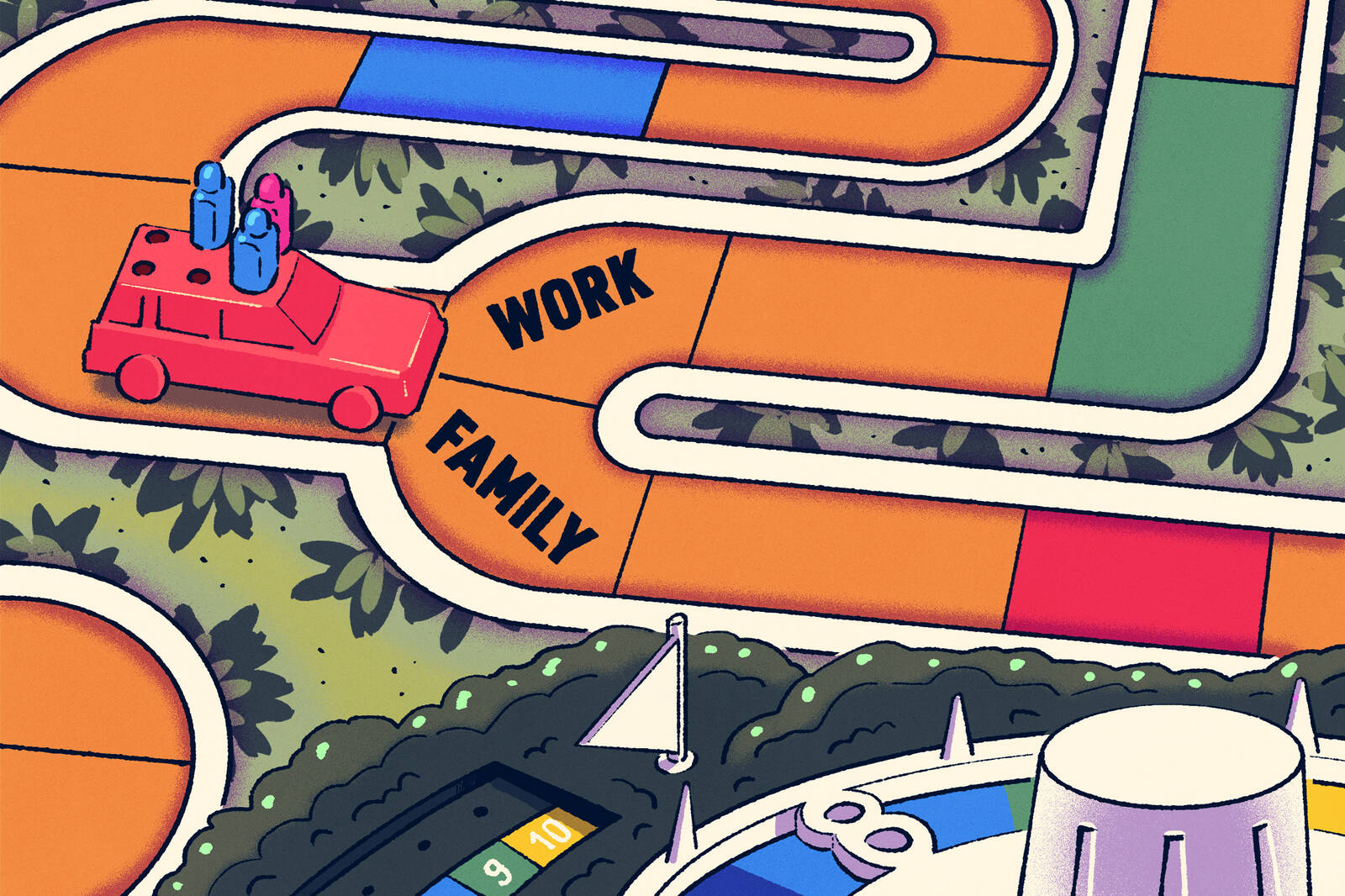Strategy Oct 1, 2025
Work First or Family First?
A new model shows why women lag behind in leadership roles—and how two policies could help narrow the career gender gap.

Michael Meier
The past ten years have seen some encouraging gains for women in business leadership: the percentage of C-suite roles held by women increased from 17 percent to 29 percent between 2015 and 2024. But that still leaves a stubborn workplace-achievement gap, where these leadership roles are twice as likely to be filled by men.
The management pipeline to fill those roles hasn’t gained much more traction for women in the past decade either. In 2015, women comprised 37 percent of corporate-manager jobs; by 2024, that figure only increased to 39 percent. Representation for women in other management categories (such as senior managers and vice presidents) was similarly anemic over the same period. Overall, the data suggests that firms are still investing more resources into hiring and promoting men than women for leadership positions.
But not all men and women compete for management positions in isolation: many marry and start families, which often requires them to make a trade-off between investing time in their family or in their careers, says Benjamin Friedrich, an associate professor of strategy at Kellogg.
“The result of those investments sends signals back to firms about how committed men and women are to working individually—which the firms might then use to decide who is deserving of assignments that ultimately build toward a managerial position,” he says. “And so it basically can create this kind of reinforcement loop.”
Friedrich and his collaborators Rune M. Vejlin, Frederik Almar, and Bastian Schulz of Aarhus University and Ana Reynoso of the University of Michigan used 25 years’ worth of data on families and the firms where they worked to track and mathematically model this family–firm interaction.
Their model replicated the real-world gender gap in corporate managerial roles and found that, among men and women who were equally qualified, women were less likely to receive managerial training and promotions.
“We’re trying to understand what types of systematic reasons lead to differences between men and women in these workplace achievements,” Friedrich says. “Ours is the first framework that puts these two pieces together, by taking seriously the fact that both couples and companies make strategic choices that are intertwined.”
Playing the game of life
Friedrich and his collaborators sourced a rich dataset from Denmark that included more than 150,000 people who began their careers between 1991 and 1995 and tracked their domestic partnerships and employment trajectories over the next 25 years.
“Denmark is a really small country where everything can be collected, hosted, and merged in a central place by the Danish Statistical Agency,” he says. “The labor market in Denmark is pretty similar to the U.S., so there are many broad patterns that we can learn from this small ‘laboratory.’”
Next, the researchers created a mathematical model of how households and companies make decisions about what to invest their resources in—and how those decisions affect each other.
In their model, companies assessed their employees’ value at three stages: the entry level, the mid-career phase, and the mature or management level. Meanwhile, individual workers made several key decisions, including their specific career path, whether to get married, and whether to pull back on work to start a family.
“The math doesn’t say, ‘Here’s what you should do.’ You can build on it, but you still have to think about what your preferences are as a society.”
—
Benjamin Friedrich
Crucially, firms in the model didn’t have direct knowledge of how working couples decided to jointly rebalance their time investments between career and family—all the companies could see is how much time each individual puts into his or her job over time. And any worker who suddenly scales back their time on the job starts to look less promotable, from the firm’s point of view.
If this sounds similar to “The Game of Life” board game, with its forking paths leading to work and marriage, Friedrich agrees. “It’s absolutely like that,” he says. “The career phases in our model map, in important ways, to the lifecycle of a household. For example, the early and middle stages of a career—your 20s and 30s—is also a time when a lot of people partner up and have kids. And that might compete with career investments they might want to make at the same time.”
A vicious cycle?
When working couples start a family, many face some difficult choices: how much time they will re-invest to home rather than to work, and which one of them will make the bigger investment. Whether because of physical demands or cultural expectations, the mother more often hits the brakes on her career. This decision sends a signal to companies, who are making their own tough choices.
“Not everyone can become a manager, so [firms] need to pick and choose who to invest in,” Friedrich says. “This is an expensive investment that involves high-profile assignments and mentoring, so the firm is thinking about who will provide the highest potential return on that training.”
Not surprisingly, firms tend to invest most in employees who put work first. When women with management potential make the rational decision to pull back on work, companies make the rational decision to put more-available men on the management track instead—even when both are equally qualified. The companies’ decision, in turn, sends a signal back to households that they can best maximize their own collective earning potential by prioritizing the man’s career.
“You get this feedback loop,” says Friedrich. “One side sends a signal to the other side, that side changes its behavior, and then it reinforces the change back on the other side.”
In the researchers’ model, sizable gender gaps emerged between women’s and men’s likelihood of getting management training and becoming a manager. But the size of this gap varied depending on how ambitious a worker was. In general, more-ambitious workers were more likely to attract support from firms to become managers.
One scenario where the trade-offs of marriage didn’t apply: workers married to a more-ambitious spouse were also more likely to get management-training support themselves, in part because such families were more likely to delay having children. Still, the researchers found that both of these ambition effects benefitted men more than women.
Friedrich and his coauthors found that the behavior of their model matched up well to patterns in the real-world data, which showed that men were 30 percent more likely than women to receive management training and 50 percent more likely to be promoted into management. “Basically, you simulate what happens in the model, and the outcomes look much the same as in the data,” he says.
Two policies
The researchers then used the model to test the effects of two policies designed to address the gender-achievement gap. The first was a gender-based quota that required firms to put equal numbers of men and women into management positions. The other was a mandatory parental leave policy for both men and women.
They found that the quota system removes gender-promotion gaps by design, but it also creates trickle-down effects for women’s careers more broadly. By forcing companies to promote equal numbers of men and women, “households see that more women can become managers—so right from the beginning, it becomes more attractive for many couples to invest in the woman’s career,” Friedrich says. That investment reinforces firms’ incentive to select talented women for management training, thereby qualifying them even more for promotion. In other words, it creates a positive feedback loop to replace the formerly harmful one.
On the other hand, adding a parental leave policy to the model strongly reduced the achievement gap between men and women—but only when they were both required to take it. That’s because mandatory leave for both parents removes any signal to their employers that one parent is more available (and thus promotable) than the other. However, this policy also produced lower overall levels of what the model calls household welfare—a general measure of positive outcome—than did enforcing a quota. “That means you could really use this as a lever to push toward equality, but households may not like it because it’s too invasive,” Friedrich says.
“Understanding these feedback loops is crucial for understanding the full impact of these policies that people have debated heavily,” he adds. “The managerial quota is pretty controversial—some countries have implemented it, and some other countries have banned it. We find winners and losers of such a policy, but it might be beneficial on aggregate. Meanwhile, the leave policy is pretty broadly accepted across many countries but may have some hidden pitfalls.”
Friedrich cautions that the model is not a perfect simulation of reality, and that their policies are not a magic bullet for ending gender-achievement gaps in the workplace. Instead, the findings should be viewed as a tool for further research.
“The math doesn’t say, ‘Here’s what you should do,’” he says. “You can build on it, but you still have to think about what your preferences are as a society.”
John Pavlus is a writer and filmmaker focusing on science, technology, and design topics. He lives in Portland, Oregon.
Almar, Frederik, Benjamin Friedrich, Ana Reynoso, Bastian Schulz, and Rune M. Vejlin. 2025. “Families’ Career Investments and Firms’ Promotion Decisions.” NBER Working Paper No. 33438.



